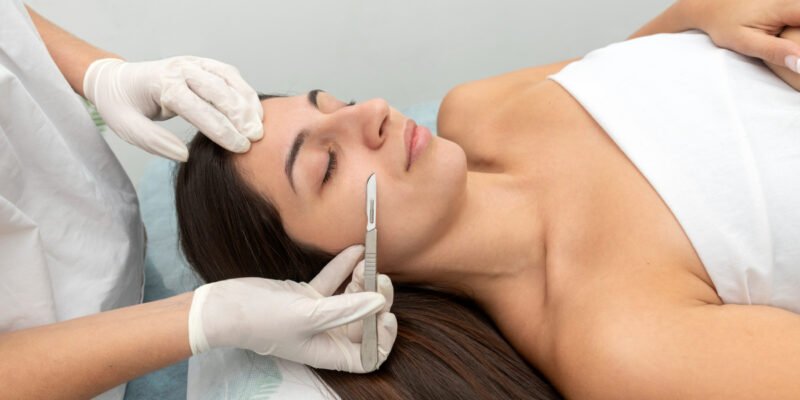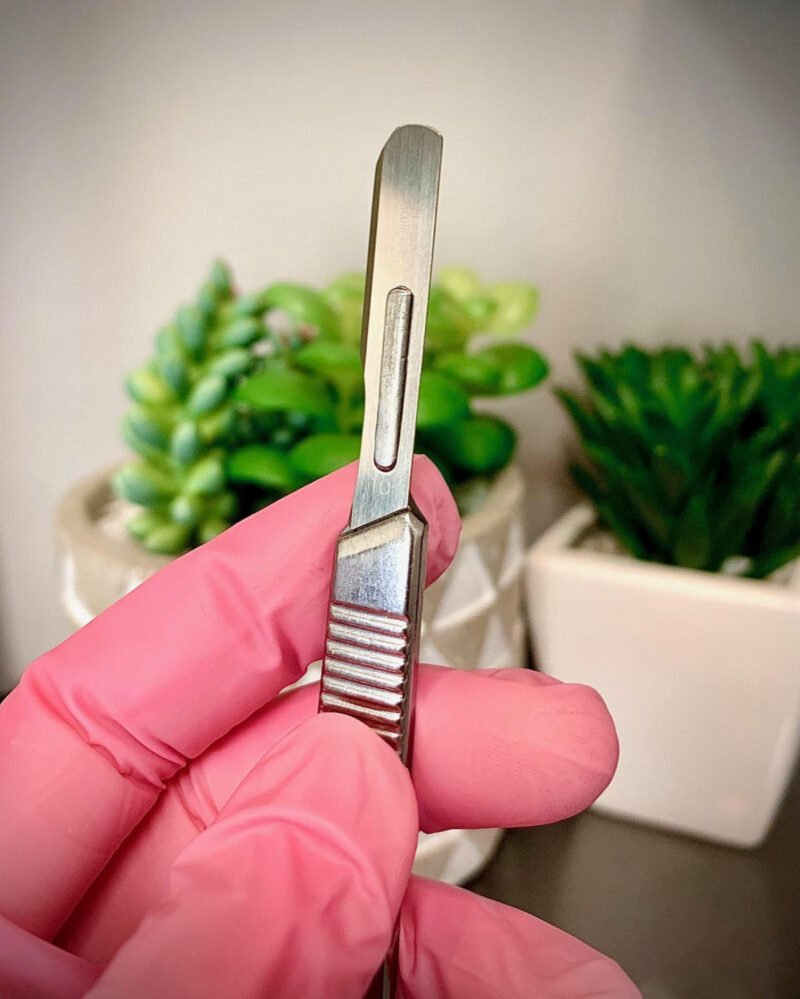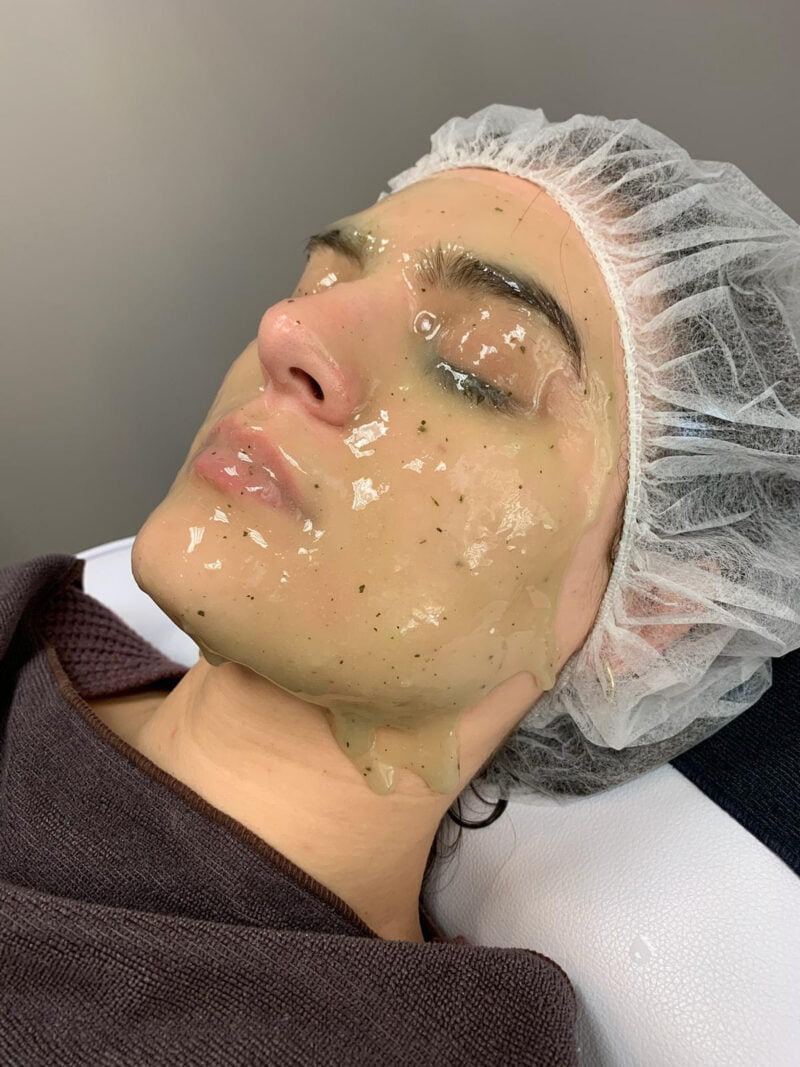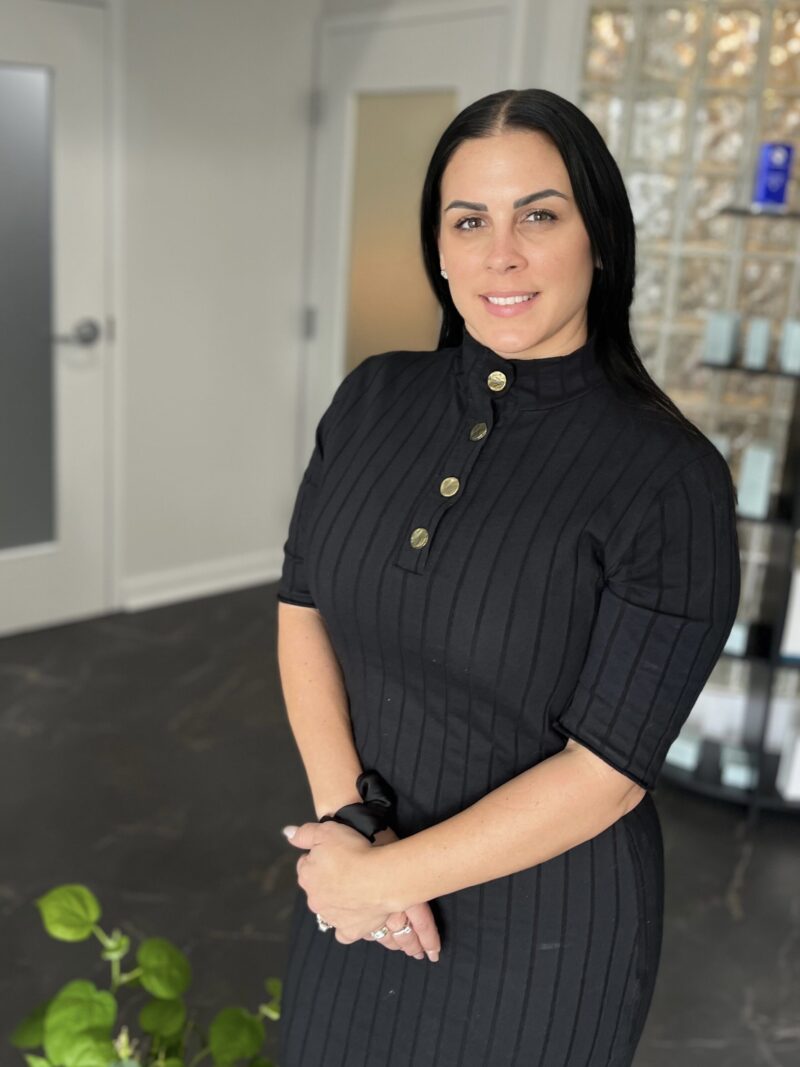Enjoy noticeably smoother, brighter skin

Skin looking a little dull? The truth is, outside of the pages of a beauty magazine, most of us aren’t blessed with naturally flawless skin that requires zero effort. Thanks to the natural cycle of your skin cell turnover, environmental factors like the weather or indoor heating and cooling, and even the products you use, your skin often needs a little extra help to shed dead or damaged skin cells and allow new, fresh skin to breathe.
That’s where dermaplaning comes in. This quick procedure is a form of mechanical exfoliation that helps brighten and soften your skin (as well as improving absorption of all your serums in the process!). Read on to learn more about this patient-favorite.
- What is dermaplaning?
- Does dermaplaning hurt?
- What are the benefits of dermaplaning?
- Is there any downtime after dermaplaning?
- Are there any side effects after dermaplaning?
- Will my hair grow back thicker or darker after dermaplaning?
What is dermaplaning?

Dermaplaning is an aesthetic medical treatment that exfoliates facial skin through gentle scraping of the skin surface using a surgical scalpel. This is different than at-home face shaving because of the sharpness of the blade used, the level of exfoliation that can be achieved, and the necessity of having your treatment performed by a physician or medical aesthetician.
Your medical provider will carefully and precisely angle the scalpel to get as close to the skin as possible to remove dry, dead skin cells and “peach fuzz,” known as vellus hair. The result is baby-soft skin, removal of facial hair, and smoother application of skincare products and makeup.
“My Diamond glow facial was the best experience. Shelby was nothing short of professional, kind, knowledgeable and helpful! I can’t wait to return! Do yourself a favor and go!”
—5-Star Google Review
Does dermaplaning hurt?
No! Because the surgical scalpel is so sharp, you shouldn’t feel any dragging or irritation as your provider scrapes your skin. This is where experience becomes crucial; an inexperienced or undertrained provider may knick the skin if they are using an improper technique.
Areas of active inflammation or even a stray pimple will not be treated during a dermaplaning appointment because it can risk infection and cause you discomfort. In these instances, you may be required to reschedule if you have a breakout prior to your appointment.
Treatment Benefits
By removing peach fuzz and dry skin, dermaplaning can help brighten your skin, reduce flakiness, and make your face touchably smooth. Dermaplaning is a fantastic way to jumpstart a healthy skincare routine, as removal of dead skin cells allows skincare products to better penetrate the skin and thus be more effective.
Because dead skin cells are notorious for clogging pores and hair follicles and leading to blemishes, you also may notice fewer breakouts after your appointment. Our patients also report that their foundation and makeup lays better on the skin, leaving them with a flawless look. After repeat treatments, some patients will also notice that their fine lines have slightly softened and sun damage or spots appear less severe.
For enhanced results, dermaplaning pairs perfectly with other services, like custom facials or chemical peels.

Recovery & Results
Is there any downtime after dermaplaning?
No—which is why so many of our patients opt to book their appointment during lunch hour and then head back to the office! You may see a slight bit of redness after treatment, but it is usually quite mild and short-lived.
We do recommend you take the rest of the day off from makeup to avoid irritating your skin post-treatment, but you’ll be able to wear makeup that evening or the next day. Because your skin barrier is vulnerable after treatment, applying a doc-approved moisturizing cream or face mask can help keep things hydrated and assist in skin repair.
“Amazing team! I felt confident I was getting excellent care. I got extremely detailed instructions, and my questions were answered satisfactorily. The procedure’s results were above and beyond my expectations.”
—5-Star Google Review
Are there any side effects after dermaplaning?
Because it is mechanical exfoliation, dermaplaning is considered a very safe option for all skin types and tones when performed by an experienced medical provider. Because the skin is not broken and the treatment only impacts the surface of your skin, side effects are very rare.
For those who have very sensitive skin or a skin condition like persistent acne or rosacea, your provider may recommend a different type of treatment to ensure your comfort and safety.
Will my hair grow back thicker or darker after dermaplaning?
This is a long-standing myth we’ve been hearing since we picked up our first razor—and thankfully it’s not true! You don’t have to worry about developing a full beard once your peach fuzz grows back. The texture and color will be exactly the same, though it may feel slightly different because it was cut straight across.
- Key Benefits
- Glossary
- Smoother Skin: Dermaplaning removes the outermost layers of dead skin cells, leaving the skin surface exceptionally smooth.
- Improved Skincare Product Efficacy: The removal of dead skin cells and hair can enhance the absorption and effectiveness of skincare products, allowing active ingredients to penetrate more deeply.
- Better Makeup Application: A smoother skin surface allows for easier and more flawless makeup application, as products will apply and sit better on the skin.
- No Downtime: Dermaplaning is a gentle, non-invasive treatment that requires no recovery time.
- Safe for All Skin Types: It is safe for most skin types and conditions, except for active acne, offering a universal solution for enhancing skin texture.
- Acne Scars: Marks or indentations in the skin left by acne, which can become less noticeable after dermaplaning due to the smoothing effect on the skin’s surface.
- Barrier Function: The skin’s ability to protect against external irritants and moisture loss; maintaining a healthy barrier is essential for skin health.
- Cell Turnover: The process of shedding dead skin cells and replacing them with new ones, a process that can be enhanced by dermaplaning.
- Collagen: A protein in the skin that provides structure and elasticity; dermaplaning can indirectly stimulate collagen production through the skin’s natural healing process.
- Dehydration: A condition where the skin lacks moisture, which can be alleviated through the improved absorption of hydrating products post-dermaplaning.
- Epidermis: The outermost layer of skin that is exfoliated during dermaplaning to reveal smoother, brighter skin underneath.
- Exfoliation: The removal of dead skin cells from the surface of the skin, which is a key benefit of the dermaplaning process.
- Hyperpigmentation: Dark spots or patches on the skin caused by excess melanin production, which can be more evenly distributed through regular dermaplaning sessions.
- Keratinocytes: The primary type of cell found in the epidermis, responsible for forming the protective barrier of the skin.
- Melanin: The pigment that gives skin its color; uneven melanin distribution can lead to hyperpigmentation, which dermaplaning can help to minimize by removing the top layer of skin.
- Peach Fuzz (Vellus Hair): Fine, soft, light-colored hair that covers much of the body and face, which is removed during dermaplaning for a smoother skin texture.
- pH Balance: The level of acidity or alkalinity of the skin, which can be maintained through proper skincare practices after dermaplaning.
- Sensitive Skin: Skin that is more prone to irritation and adverse reactions, which may require special care before and after dermaplaning.
- Serum Absorption: The increased effectiveness of skincare products after dermaplaning, as the removal of dead skin cells allows for better penetration of active ingredients.
- Skin Resurfacing: A broad term for procedures that improve the skin’s appearance by removing the upper layers, of which dermaplaning is a non-invasive example.
- Surgical Scalpel: A medical tool with a very sharp blade used in dermaplaning to gently scrape off the top layer of dulling dead skin cells.
- Texture Irregularities: Uneven skin surface conditions, such as bumps or rough patches, which can be smoothed out with dermaplaning.

Our Licensed Aesthetician
Our Hagerstown medical aesthetician Shelby Mobley offers a full range of modern skin treatments at the Plastic Surgery Services Skin Care Clinic. With years of experience and an in-depth knowledge of medical-grade skincare products, her mission is to help you feel great about yourself by achieving the best results possible for your skin!
Ready to unveil your gorgeous glow? Contact us today to schedule your dermaplaning treatment!

Our VIP Membership is here!
We’ve got the PERFECT solution for maintaining your facial needs! Elevate your skincare routine with our VIP Membership and enjoy your favorite treatments at special prices. Memberships come in two tiers, so you can pick the plan that works for you, plus all VIP members get one free dermaplaning a month and save on skincare products.
References »
American Society of Plastic Surgeons. Dermabrasion (https://www.plasticsurgery.org/cosmetic-procedures/dermabrasion) Accessed 4/17/24.
Tijani AO, Frempong D, Kaur J, Sergent S, Shaw K, Lessaint R, Al Shawi M, Verana G, Puri A. Dermaplaning for Transdermal Drug Permeation Enhancement: A Qualitative and Quantitative Assessment. AAPS PharmSciTech. 2023 Feb 1;24(2):54. doi: 10.1208/s12249-023-02505-y. PMID: 36725790.


